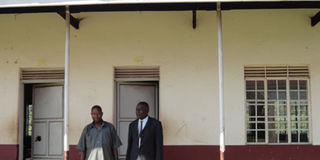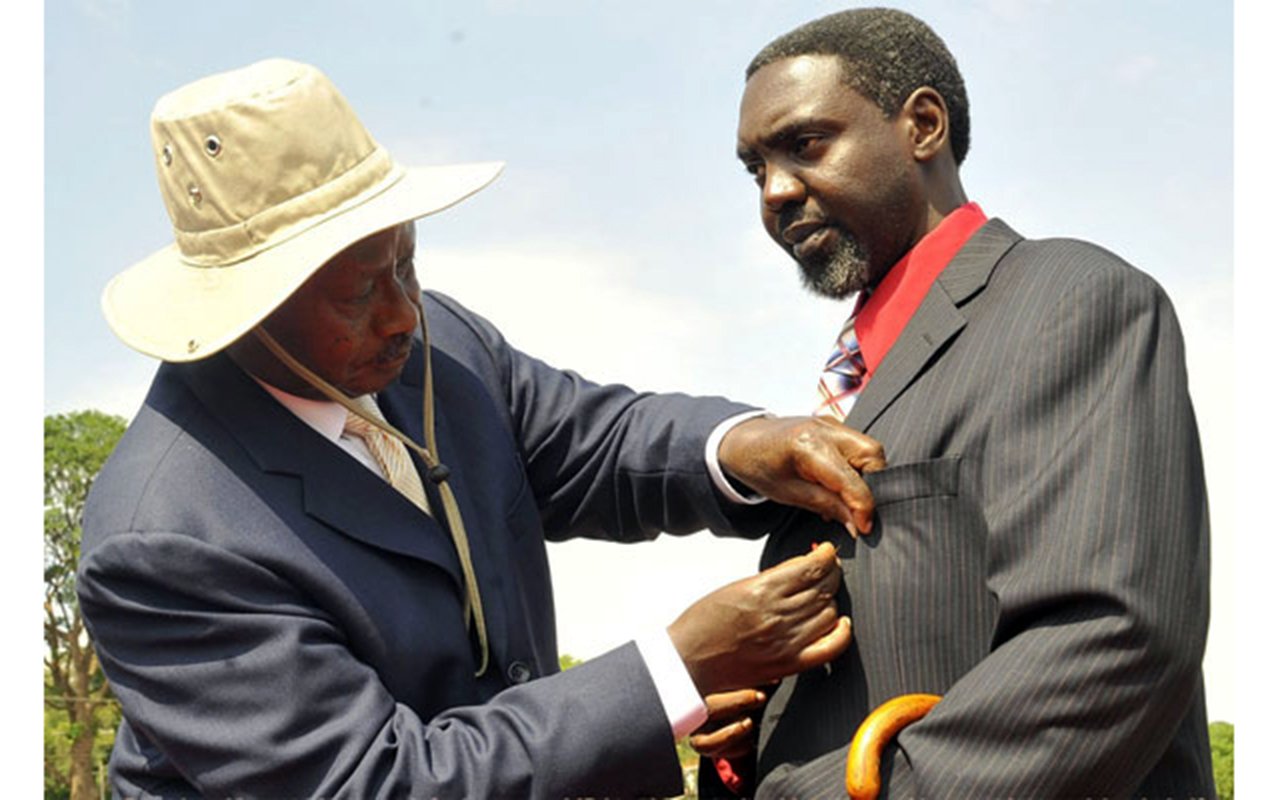Chahi: A secondary school made by government and the community

PTA chairman, Didas Nibiyiyize (left) and Abraham Katwanga (right), the head teacher of the school.
When the government initiated the idea of Universal Secondary Education (USE) in 2007, it was greeted with a dose of skepticism due to the seemingly high cost of setting up the necessary infrastructure that goes with such an undertaking.
But the idea of “Seed Schools” was mooted as a practical remedy to the immediate challenge of setting up infrastructure. The basic idea ran as follows: “Let each sub county offer land; let the community identify what they are able to contribute; let the government, where feasible, construct classroom blocks and pay the teachers who work in the school.”
It was, and still remains, the parent’s duty to pay for their child’s lunch and school uniform, according to the Ministry of Education’s policy. This, however, is not mandatory and a child may not be sent back home on account of the lack of these.
Increase in enrollment
A UN report, released when USE started, said, “Uganda has the worst secondary-school, enrollment rates in the world with only 34 per cent of eligible children enrolled into secondary school.” Between 2006 and 2011, the number of candidates sitting O-Level exams rose by 54 per cent from 172,000 to 265,000. Evidently, USE has been instrumental in improving enrolment.
In a research paper, Yamano Takashi and Pallegedara Asankha, of the National Graduate Institute for Policy Studies in Tokyo, Japan, reported, USE had had no impact on private secondary school enrolment therefore the significant increase in enrollment is solely attributable to the initiative. However, the challenges of setting up “Seed Schools” were daunting from the beginning. In 2007, the Ministry of Education reported that up to 50 per cent of the teachers recruited to teach in these schools had refused to start duties on the account of the rural locations where they had been posted. But the success of Chahi Seed School in Chahi Sub county, Kisoro, typifies the saying, “Do not ask what your country can do for you, ask what you can do for the country”.
Vibrant and friendly
“Chahi Seed School was a very new idea in this sub country,” observes Abraham Katwanga, the head teacher. “But together we were determined to make it work using all the resources we had. This place has plenty of rocks, which we used to put up some of the first buildings.”
These combined efforts included resident and non-resident community members. This has given birth to a vibrant, friendly school atmosphere that holds promise for many children in the neighbouring villages many of whose parents barely live on more than Shs3,000 a day. It all began when they raised Shs37m to purchase a piece of land, about half an acre in size, onto which the government would build the classrooms. “This school was founded in 2006,” recalls Katwanga. “Without the support of some well-meaning individuals who hail from this area like Pius Bigirimana, among others, the idea would never have taken off the ground.”
At the time of its founding, Chahi Secondary School was the only secondary school in this sub county of about 25,000 residents. Students had to trek more than 12km to find a school which in itself was a powerful contributor to drop-out rates. “The longest any student walks to our school now is seven kilometres,” Katwanga muses. “It is still a long distance but much less than 12km. Both parents and students are happy about this development. We have seen an increase in student enrollment as a result.”
Expansion
The school has a population of 933, which is a testimony to its growth. Having started with 93 students, the school has registered expansion of about 10 times. Chahi’s 41 per cent female population falls within the general margin of prevalence associated with USE schools which, on the whole, has seen increased female enrolment.
UN Educational, Scientific and Cultural Organisation 2010/11 World Data in education reported Uganda’s female enrollment at 499,386 (46 per cent) out of a total of 1,088,744 in 2009. Yamano and Pallegedara reported that in 2005 the female, secondary school enrolment in Uganda stood at 19 per cent.
So, at 1:27, Chahi may, numerically, have the best teacher-student ratios of the USE schools in Uganda, even if only 16 of its 34 teachers are government-paid. The rest are paid out of a pool of funds, some of which are contributed by each parent at an agreed rate of Shs40,000 per term. The Ministry of Education recommended a teacher-student ratio of 1:60 in 2008.
Shortfalls
“However,” warns the head teacher, “The school still grapples with a shortage of classroom blocks and our 933 students have to be fitted, 110 in each class stream.” At any given time, one teacher stands in front of 110 students. As such, this classroom shortage insinuates a subtle staff shortfall that is rampant among USE schools.
The ministry, in an extensive 2008 report, elaborated on the shortage of teachers for the USE programme. Another one by Keith Lewin, which was presented during a 2006 Conference of Commonwealth Education Ministers in Cape Town, South Africa, showed there were 37,000 secondary school teachers before USE started.
To meet the basic 1:60 teacher-student ratio, he argued, 45,000 new teachers would need to be recruited to match the increased USE student enrollment. However, for this recruitment to be successfully implemented, the government would need to have the financial resources to triple the teaching staff wage bill, which is an impossible feat, presently.
Fundraising drives
Undoubtedly, schools like Chahi represent a consistently, poignant “out of the box” operation model even if they grapple with the general understaffing and under-resourcing challenges prevalent in USE schools. “We started with almost nothing. We have and continue to rely on serious fundraising drives through charity walks and other such arrangements. That is how we bought the land on which the school stands,” explains Didas Nibiyize, chairman of the Parents Teachers Association (PTA). “We began with only the lower secondary school classes from Senior One to Senior Three but parents were motivated to share their resources and expand the school.”
In 2011, Chahi boasted of “producing” the best performing student as well being the best-performing government school in Kisoro District. With a proportion of 44 per cent of the students passing in first and second grades of the O-Level, final exams and the rest in third grade, Chahi, like many USE schools, still struggles to bring the calibre of final scores up to a respectable level.
On January 12, even as Chahi officially received two classroom and two toilet blocks, whose construction was funded by the World Bank, it was clear its efforts at growth have attracted high-level stakeholders. “We still have a long way to go; we need more teachers and teaching aids and facilities. The average distance walked to school by students is seven kilometres. We have had to move our day to start at 8:30am instead of 8am. We still need a school bus, staff living quarters, a dining hall, a main hall, a soccer ground among other facilities.” Katwanga says. “But we are working hard,” Nibiyize chips in. “We have got a classroom block under construction using funds raised by the PTA at the moment.”
Good grades
“Chahi Seed School reminds all of us to take it upon ourselves to contribute to the education of our children by doing all that is within our power to work with the Government. I have utilised my friendships in America to be able to obtain school fees to support up to four students at the school,” explains Pius Bigirimana. “From the sales of my book, I have offered Shs100,000 to every student who obtains a distinction in a science subject and Shs200,000 to every science teacher whose student scores that distinction. The performance shows me this has been a good incentive so far.”
For now, Chahi Secondary School is a successful example of the seed school concept and a demonstration that there remains sufficient community drive to partner with the government. This drive has been commended by naming some of its classroom blocks after those deemed to have contributed the most to its well-being.




